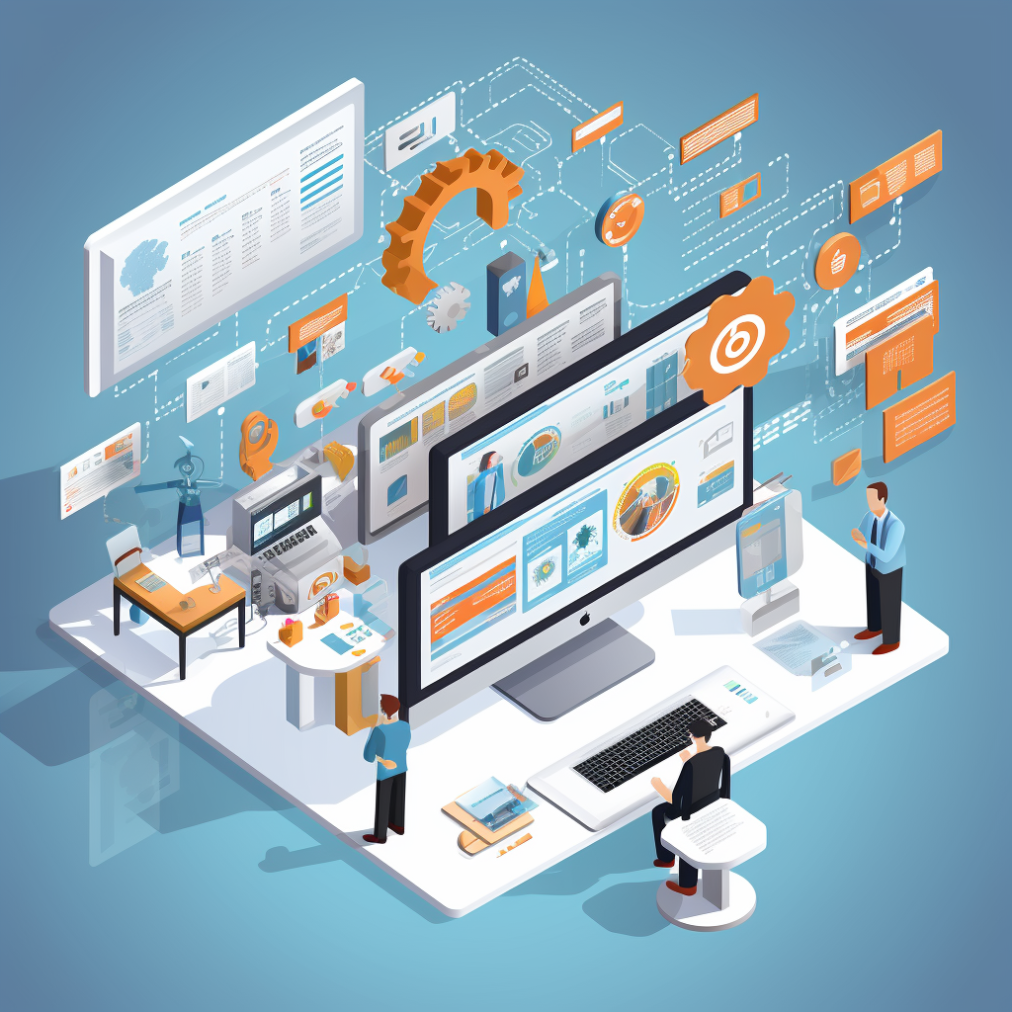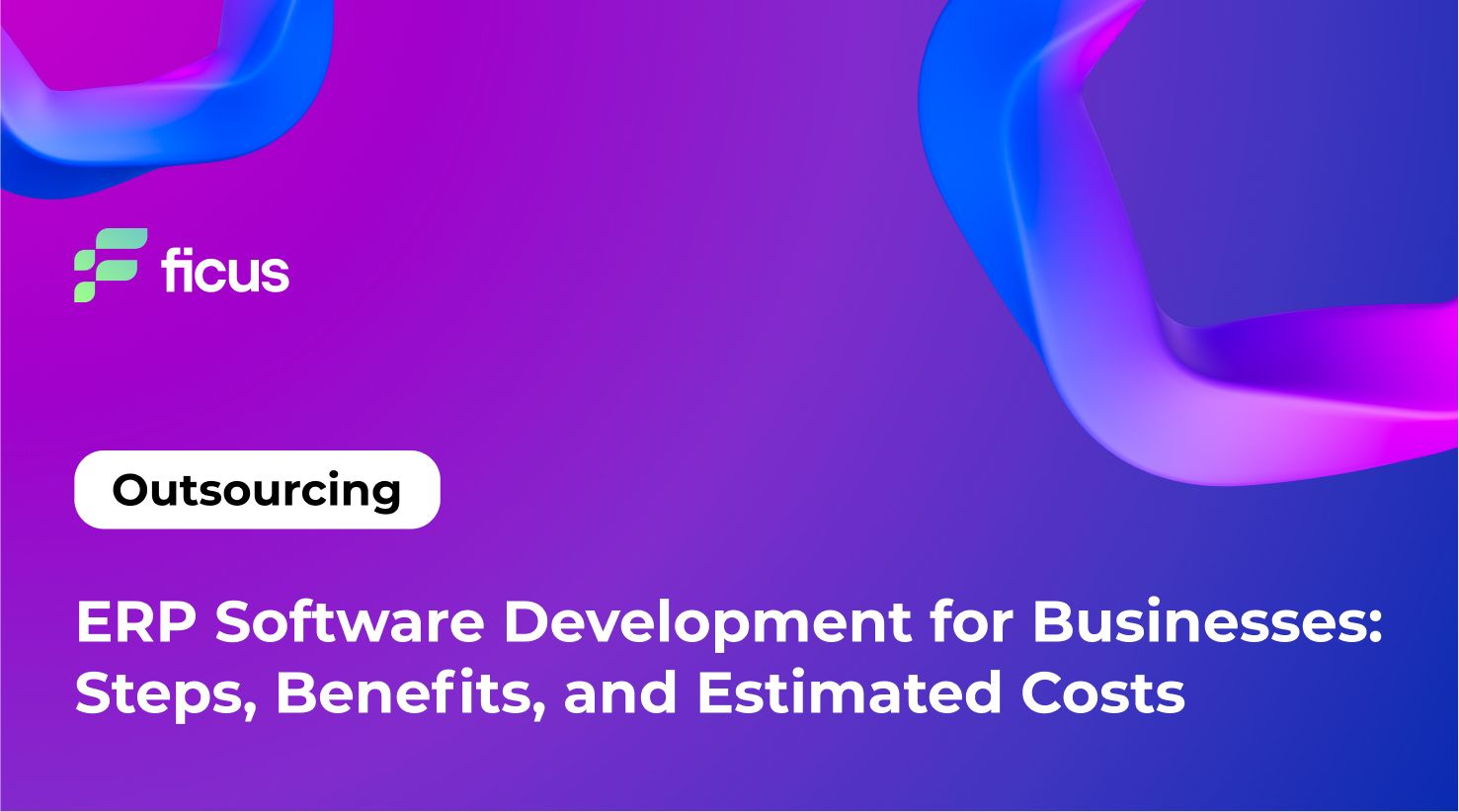As businesses expand, the need for reliable management tools becomes critical. In 2021, more than 50% of businesses that implemented software development ERP reported effective control over accounting, logistics, inventory, and personnel. In contrast, companies without ERP systems faced operational problems and financial losses. An ERP solution is an indispensable asset that allows companies to optimize their workflows and save time and resources. This publication reveals all the ins and outs of ERP software development, providing a roadmap for creating customized solutions that seamlessly meet diverse business requirements and improve operational efficiency.
- ERP software streamlines business processes, improving efficiency and collaboration.
- <span style=”font-family: Arial; font-size: 13px;”>It offers accurate forecasting, cost-efficiency, risk management, and inventory monitoring. </span>
- ERP development phases include planning, examining capabilities, data management, testing, and post-implementation.
- Factors affecting ERP development cost include company size and customization.
What Is ERP Software Development
Let’s demystify the field of ERP software development. Essentially, enterprise resource planning (ERP) software organizes the management of core business processes in real time. This modular software is a centralized hub collecting, storing, and interpreting data from different departments into a single database. This allows employees to access data from specific departments, facilitating targeted information retrieval. At the same time, ERP software specialists who control all business processes get comprehensive access to all departments. Understanding the intricacies of software development ERP and the systematic ERP software development process is fundamental for businesses that strive for operational excellence.

Who Would Benefit From Building an ERP System?
Who will benefit from implementing an ERP system does not depend on the business size. It is becoming a strategic imperative for medium and large enterprises looking to optimize their operations. Panorama ERP’s research highlights the widespread adoption of ERP systems across industries in 2022, including manufacturing, IT, distribution, the public sector, professional services, retail, and healthcare. Navigating the ERP landscape is challenging for global businesses, given the financial considerations and the diverse functionality of off-the-shelf or customized solutions. The difficulty of decision-making is often due to a lack of awareness, forcing companies worldwide to carefully assess their needs during the ERP software development process.
Advantages of ERP Software
Companies, regardless of size, have realized significant benefits, achieving a notable 20% budget reduction through ERP implementation. This highlights the key benefits that await companies that implement ERP systems. Delving deeper into these benefits, a more detailed analysis reveals the transformational impact of streamlined processes, real-time access to data, improved collaboration, and significant cost savings – all signs of ERP software development excellence.
- Optimization of Business Processes
Optimizing business processes through strategic ERP software development is the key to increasing efficiency for enterprises and mid-sized companies. By using HR, supply chain, and inventory management modules, companies save time and automate daily tasks, freeing them from routine paperwork. Reducing the number of human errors is also important. Integrating these modules into a systematic ERP software development process marks a transformative path, providing streamlined operations and increased accuracy in the dynamic landscape of modern business.
- Real-Time Data Access
In the field of ERP software development, the primary objective is to provide access to data in real-time. Companies that capitalize on this opportunity through strategic ERP software development gain a competitive advantage. Continuous reporting and access to real-time data allow companies to make effective, informed decisions. Such dynamic access to reliable information becomes the cornerstone of flexibility and adaptability in a rapidly changing business environment. Incorporating such capabilities into a systematic ERP software development process is crucial for companies looking to stay ahead in the information age.
- Better Business Collaboration
Better business collaboration is the foundation of success in the era of software development ERP. This synergy between business partners creates seamless information exchange, fostering high-quality partnerships between different parties. The transformational impact is evident as companies see a significant 30% increase in collaboration productivity through strategic ERP implementation. This shared benefit is a testament to the positive effects of integrating such functionality into a holistic ERP software development process that drives efficiency and growth.
- Cost Savings on Legacy Support
Saving the cost of maintaining legacy is a key benefit of strategic ERP software development. An ERP system becomes an important ally for companies that need to support legacy systems. Maintaining comprehensive records of product uniqueness helps to reliably protect and establish a market advantage. In 2021, more than 65% of small businesses took advantage of legacy ERP services, underscoring their effectiveness. This innovative approach to ERP software development protects historical data and ensures that businesses are future-proofed by optimizing resources and promoting sustainable growth.
- Reduction of Unnecessary Operations
The strategic implementation of ERP software development solves the problem of the proliferation of unnecessary operations in medium and large companies. The ERP system becomes an important ally, using the power of artificial intelligence and business intelligence to analyze important elements for business planning. This reduces unnecessary operations and frees up valuable space for priority tasks, optimizing the use of time. Seamlessly integrating such capabilities into the overall ERP software development process allows companies to conduct streamlined and efficient operations, aligning their efforts with strategic priorities.
- Improved Work Performance
Improving work efficiency is the cornerstone of strategic software development ERP. Increasing productivity allows you to comprehensively analyze the effectiveness of each employee, facilitate the development of individual development plans, and increase the effectiveness of collaboration. An ERP system revolutionizes this process in an environment where extensive activity reports are the norm. By calculating the efficiency of business processes it streamlines procedures, creating a harmonious balance between time and work. Integrating such improvements into the ERP software development process marks a paradigm shift, fostering a culture of continuous improvement and efficiency.
Disadvantages of ERP Software Development
You can identify the inherent challenges by navigating the ERP software development landscape. Understanding the intricacies and potential challenges of the ERP software development process enables businesses to make informed decisions, ensuring a strategic and seamless implementation that meets their unique needs and goals.
- Cost
Cost is a critical factor that holds many businesses back from developing ERP software. Implementing a comprehensive project covering the entire company entails significant costs, often prompting consideration of third-party solutions with subscription models. However, the long-term viability of such savings remains questionable. Opting for custom ERP software development involves paying for the program and providing flexibility and convenience, often leading to lower operating costs over time. Strategic decision-making in the ERP software development process allows you to balance the initial costs with long-term benefits.
- Staff Training
The importance of ERP system training cannot be overstated. The effective operation of ERP systems depends on thorough staff training to ensure that procedures are followed correctly and reports are processed accurately. Using off-the-shelf templates like resources without an experienced vendor proves to be a difficult and expensive process. Unwillingness to invest in comprehensive staff training can lead to increased costs and reduced competitiveness in the advisory services market. Recognizing the importance of continuous learning becomes integral to navigating potential issues within the overall ERP software development process.
- System Complexity
System complexity is a significant problem in some ERP systems, especially off-the-shelf products. While these off-the-shelf solutions may initially be appealing with their features, they often lead to confusion in management and workflow. Choosing a customized ERP product is a winning choice that avoids complexity by being closely aligned with business requirements and priorities. However, realizing the benefits of ERP is not instantaneous; it depends on the abilities and skills of the staff. The final implementation stage requires education, training, and a keen understanding of business goals as part of the overall ERP software development process.
Third-Party vs. Custom-Made Solutions
Third-party and custom solutions are an important crossroads in the ERP space. There are advantages to choosing between off-the-shelf resource planning systems and custom solutions, and each requires careful consideration during the ERP software development process. Companies must weigh the advantages and disadvantages of each option, understanding how well it fits their unique business needs and goals.
Third-Party Solutions
Third-party ERP software development solutions offer immediate deployment after an initial payment, and software-as-a-service providers such as Acumatica, Sage Intacct, and SAP Business One cater to small and medium-sized businesses. Larger enterprises can consider Oracle NetSuite, SAP S/4 HANA, and Microsoft Dynamics. Despite some flexibility, these solutions often lack adaptability and may require developers to manipulate the source code and integrate APIs. The learning curve can be steep, especially for larger companies where integration can take months or even years. Although third-party systems make ERP development easier, their cost-effectiveness depends on factors such as the type of company and the experience of employees.
Custom-Made Solutions
Custom ERP software development solutions offer endless possibilities compared to the limitations of third-party alternatives. Think of it as a blank canvas on which your imagination shapes the functionality, from customized accounting records to accurate lead analysis for your sales team. Customized solutions foster symbiosis between departments by eliminating unnecessary features that may accompany third-party options. While cost and development time are important considerations, a thorough development process ensures that your ERP system accurately meets your business needs, creating a comprehensive guide for simplified training and problem-solving.
Need an ERP software development company?
Contact us
ERP Software Development Process
ERP software development is a complex process that requires attention to many variables. This complexity is due to the need to consider the various roles in different departments, each with specific titles and professions. Creating navigation systems and restrictions for user groups requires a significant amount of time from developers. To help ease this difficult path, we’ve outlined the stages of the ERP software development process, shedding light on the intricacies of creating a customized and effective enterprise resource planning system.
Clarify Your Idea
At the initial stage of ERP system development, it is necessary to carefully clarify your idea and set clear goals. Developers need clear requirements to start the project. Reputable software vendors help customers with the list of features and provide a preliminary project estimate. As a client, you should clearly articulate your company’s internal structure to give developers an idea of the organizational structure of the software. A comprehensive description of all the planned processes to be integrated into the ERP system is vital to ensure a common understanding of the process of joint ERP software development.
Taking Care of UI/UX Design
When developing software for ERP systems, user interface (UI/UX) development is a significant challenge due to the large number of user roles, navigation elements, diagrams, and interactive components. The challenge is seamlessly integrating all the elements and user roles while maintaining a clutter-free appearance. The importance of properly designed wireframes at this stage cannot be overstated. These wireframes, which represent the overall layout, guide the placement of future components on the screen. In collaboration with designers and business analysts, approving wireframes becomes a key step in the detailed ERP software development process. However, the layout is not the only aspect; optimal color schemes, fonts, buttons, and careful attention to detail enhance the appeal and usability of the final version. When choosing a technical partner, ensure they offer quality UI/UX design services to create a cohesive and user-friendly ERP solution.
Tech Stack
In ERP software development, the technical stack is an integral part that goes beyond the appearance and focuses on the architecture and content of the software. Engineers use various technologies and development approaches depending on the platform chosen. For desktop ERP systems, developers can use C++/C# for Windows or Swift/Objective-C for macOS. In web projects, the technical stack includes Angular, Bootstrap, JavaScript, Node.js, and various frameworks such as jQuery. The final set of technologies depends on the functions and requirements of the project, which emphasizes the importance of fine-grained solutions in the complex ERP software development process.
Integrations
Developing software for ERP systems involves integrating various third-party products, which is commonplace. Services such as G Suite, Office 365, FreshBooks, and others can be easily integrated into ERP systems using APIs provided by third-party software. This integration allows ERP software developers to access and display information in the ERP system, enriching it with new business insights. Third-party integrations can also replace large modules in ERP system development, saving small and medium-sized companies time and money by avoiding creating modules from scratch and transferring data from previous databases. Strategic integration solutions contribute to the overall efficiency and versatility of the ERP software development process.
Quality Assurance
Quality assurance in ERP software development is a multifaceted process that requires the involvement of experienced quality control engineers. The testing process consists of various stages of software development ERP, including unit testing to evaluate the compatibility of new features with existing modules and system testing to verify that the final integrated product meets the original requirements. This complex process includes five types of functional testing and five types of non-functional testing, emphasizing the time-consuming nature of quality assurance in the complex ERP software development process.
The Cost of ERP Software Development
The price of ERP software development is a key issue for entrepreneurs that depends on various factors such as functions, company size, roles, and more. This complex concept encompasses costs beyond development and affecting the overall cost. The main factors include:
- Development and integration: Building software involves a team of developers, designers, testers, and project managers. The complexity of ERP and the need for resources results in significant costs.
- Training: Adapting to a new workflow takes time, resulting in a temporary decrease in productivity and increased costs.
- Company customization: Outdated processes may need to be adjusted to align with ERP standards, requiring additional management time and costs.
- Maintenance: Whether running on local hardware or in the cloud, ERP systems require maintenance, hardware replacement, and network checks.
- Updates: Changes in workflow require regular software updates to ensure that the software remains relevant and efficient.
Depending on the modules, company size, and number of users, the final cost ranges from $50,000 for small solutions to $500,000 for large enterprises with more than 100 users, making ERP software development a customized investment.
Final Thoughts
Ultimately, companies can embark on a transformation path to operational excellence by embarking on an ERP software development journey. In this comprehensive whitepaper, you’ll find information on the key steps, benefits, and expected costs associated with developing an ERP system that is tailored to your business’s unique needs. From the benefits of streamlined processes, real-time access to data, and enhanced collaboration to the potential challenges of system complexity, staff training, and choosing between third-party and in-house solutions, companies gain valuable insight into the complex landscape of software development ERP.
With a deep understanding of the ERP software development landscape, Ficus Technologies offers customized solutions, ensuring a seamless ERP software development process. Leveraging its broad technology stack, UI/UX design expertise, and quality assurance commitment, Ficus Technologies is a trusted ally, guiding businesses to successful ERP system implementation, process optimization, and sustainable growth.
ERP software development is crucial for businesses as it streamlines processes, improving efficiency and collaboration. It offers benefits such as accurate forecasting, cost efficiency, risk management, and enhanced inventory monitoring. By centralizing data, ERP enables improved decision-making and ensures every department accesses relevant information, fostering a more productive and target-oriented organization.
The Software as a Service (SaaS) model for ERP software development offers a cloud-based, subscription-oriented approach. Instead of purchasing and hosting ERP software locally, users access it remotely via the internet. This model provides benefits like scalability, accessibility, and reduced upfront costs. SaaS ERP solutions are maintained and upgraded by the service provider, freeing organizations from extensive IT responsibilities. Users can typically customize configurations to some extent. SaaS ERP is advantageous for businesses seeking cost-effective, easily accessible, and scalable ERP solutions that align with their specific needs.









As a software development enthusiast, I thoroughly enjoyed reading the article. The author’s comprehensive coverage of the topic, including the step-by-step process, benefits, and estimated costs of ERP software development, is commendable. The article is well-researched and provides valuable insights into the subject matter.
Having worked in the field of software development for businesses, I found the article to be an informative and insightful read. The author has meticulously covered the essential steps involved in ERP software development, providing valuable insights into the benefits and estimated costs associated with such projects. The article’s clarity and organization make it easy to follow.
As someone interested in ERP software development, I found the article to be a valuable resource. The author has done a commendable job of outlining the key steps involved in developing an ERP system, while also highlighting the benefits and estimated costs associated with it. Overall, this article serves as an informative guide for businesses seeking to embark on an ERP software development journey.